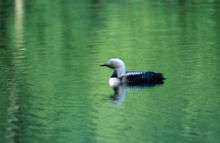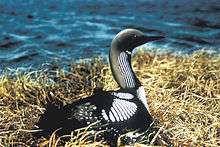Pacific loon
| Pacific loon | |
|---|---|
 | |
| Scientific classification | |
| Kingdom: | Animalia |
| Phylum: | Chordata |
| Class: | Aves |
| Order: | Gaviiformes |
| Family: | Gaviidae |
| Genus: | Gavia |
| Species: | G. pacifica |
| Binomial name | |
| Gavia pacifica (Lawrence, 1858) | |

The Pacific loon or Pacific diver (Gavia pacifica), is a medium-sized member of the loon, or diver, family.
Taxonomy and etymology
The Pacific loon, previously considered conspecific with the similar black-throated loon, was classified as a separate species in 1985. The genus name Gavia comes from the Latin for "sea mew", as used by ancient Roman naturalist Pliny the Elder.[2] The specific epithet pacifica is Latin for the Pacific Ocean, the term meaning "peaceful".[3]
The phylogeny of this species is debated, with the black-throated loon and the Pacific loon traditionally being considered sister species, whereas a study using mitochondrial and nuclear intron DNA supported placing the black-throated loon sister to a clade consisting of the Pacific loon and the two sister species that are the common loon and the yellow-billed loon. In the former phylogeny, the split between the Pacific loon and the black-throated loon is proposed to have happened about 6.5 million years ago.[4]
Description
Breeding adults are like a smaller sleeker version of common loon. They measure 58–74 cm (23–29 in) in length, 110–128 cm (43–50 in) in wingspan and weigh 1–2.5 kg (2.2–5.5 lb).[5] They have a grey head, black throat, white underparts and chequered black-and-white mantle. The black throat has purple reflections. Non-breeding plumage is drabber with the chin and foreneck white.[6] Its bill is grey or whitish and dagger-shaped.
In all plumages, lack of a white flank patch distinguishes this species from the otherwise very similar black-throated loon. The Pacific loon can be differentiated from the red-throated loon in winter by the latter's paler look, the fact that the red-throated loon has less of a contrast between both the crown and hindneck and the throat, and the bill that looks to be upturned.[6]
This bird makes a yodelling high-pitched wailing call on its breeding grounds, as well as harsh growls and barks, like its harsh kok-kok-kok-kok call.[6]

Habitat and range
The Pacific loon breeds on tundra lakes, and winters in the open ocean or other large bodies of water. It breeds primarily in northern Canada and eastern Siberia, and winters along the Pacific coast of North America.[7]
Movements
Unlike other loons/divers, this bird may migrate in flocks. It winters at sea, mainly on the Pacific coast, or on large lakes over a much wider range, including China, Japan, North Korea, South Korea, United States and Mexico. It has occurred as a vagrant to Greenland, Hong Kong, Great Britain, Spain, Finland and Switzerland (Dec 2015).[8]
Behaviour
Breeding
The Pacific loon constructs its nest on the ground near deep lakes. This nest is made out of piled-up vegetation.[9]
This loon lays a clutch of one to two light buff or green eggs with brown spots of various sizes. These eggs typically measure 76 by 47 millimetres (3.0 by 1.9 in). Although the eggs are laid a few days a part, they can usually be seen to hatch at intervals not more than a day. Incubation lasts 23 to 25 days.[9]
Diet
This species, like all divers/loons, is a specialist fish-eater, catching its prey underwater. It also forages in groups, usually swimming under schools of fish and forcing them up towards the surface.[9] It does, although, generally feed closer to the shore than other loons.[6]
References
- ↑ BirdLife International (2012). "Gavia pacifica". IUCN Red List of Threatened Species. Version 2013.2. International Union for Conservation of Nature. Retrieved 26 November 2013.
- ↑ Johnsgard, Paul A. (1987). Diving Birds of North America. University of Nevada–Lincoln. ISBN 0-8032-2566-0.
- ↑ Jobling, James A (2010). The Helm Dictionary of Scientific Bird Names. London: Christopher Helm. p. 288. ISBN 978-1-4081-2501-4.
- ↑ Sprengelmeyer, Quentin D. (2014). A phylogenetic reevaluation of the genus Gavia (Aves: Gaviiformes) using next-generation sequencing (Master of Science). Northern Michigan University.
- ↑ (2011).
- 1 2 3 4 Bull, John L.; Farrand, Jr., John (1994). The National Audubon Society Field Guide to North American Birds: Eastern region (2 ed.). Knopf. pp. 338–339. ISBN 978-0-679-42852-7.
- ↑ Peterson, Roger Tory (2002). A Field Guide to the Birds of Eastern and Central North America (5th ed.). New York, NY, USA: Houghton Mifflin Harcourt. p. 9. ISBN 978-0-395-74047-7.
- ↑ "Pacific Loon Spotted on Finnish Lake". YLE.fi. Yleisradio Oy. November 16, 2010. Retrieved January 29, 2011.
- 1 2 3 Hauber, Mark E. (1 August 2014). The Book of Eggs: A Life-Size Guide to the Eggs of Six Hundred of the World's Bird Species. Chicago: University of Chicago Press. p. 54. ISBN 978-0-226-05781-1.
Further reading
| Wikimedia Commons has media related to Gavia pacifica. |
The following articles deal with separation of Pacific diver/Pacific loon from black-throated diver/Arctic loon:
- Birch, A. and Lee, C-T, 1997, Field identification of Arctic and Pacific Loons, Birding 29: 106-115.
- Birch, A and Lee, C-T, 1995, Identification of the Pacific Diver - a potential vagrant to Europe, Birding World 8: 458-466.
- Harrison, Peter (1988). Seabirds: An Identification Guide. London: Christopher Helm. ISBN 0-7470-1410-8
External links
- Stamps (for Canada)
- Pacific loon photo gallery - VIREO
